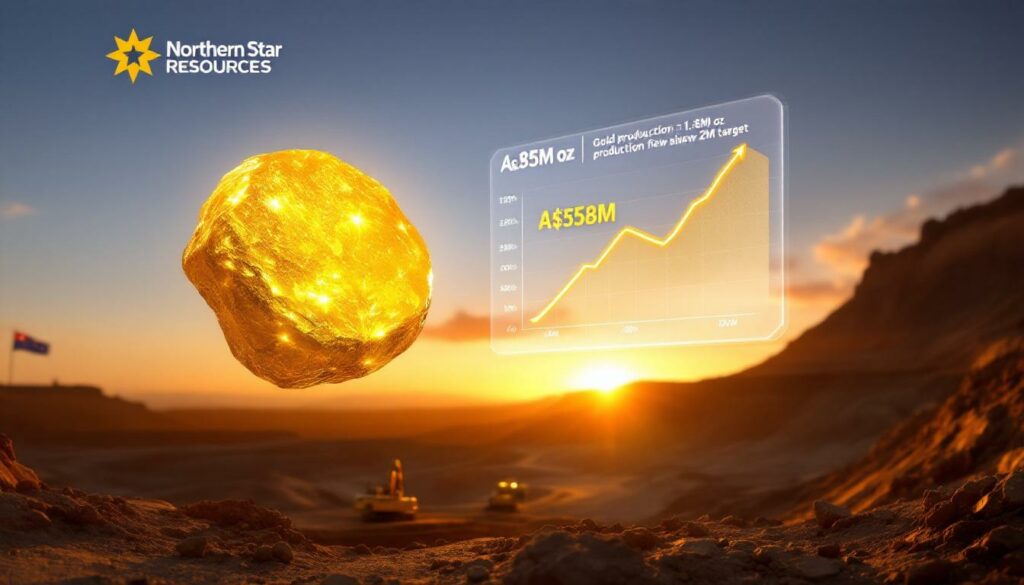Why is Northern Star's 2 Million Ounce Goal Now Out of Reach?
Northern Star Resources, one of Australia's premier gold miners, has officially acknowledged that its ambitious target of producing two million ounces of gold annually will not be achieved in the near term. In a significant adjustment to previous forecasts, the company now projects maximum production of 1.85 million ounces for the 2026 financial year.
This revised outlook comes as a disappointment to investors who had been anticipating the company reaching the 2Moz/y milestone. Despite the setback, Northern Star did post record group free cash flow of A$536 million and gold sales of 1.634 million ounces in the 2025 financial year.
CEO Stuart Tonkin has been transparent about the challenges faced by the company: "It's been a challenging 12-month period as we have faced productivity and cost headwinds, particularly at KCGM, our largest asset. This led us to confirm that we will not reach our ambitious two-million-ounce per annum group target in FY26."
Key Factors Behind the Production Shortfall
The primary reason for missing the two-million-ounce target is underperformance at the company's flagship Kalgoorlie Consolidated Gold Mines (KCGM) operation. Tonkin specifically noted that KCGM is not yet capable of delivering its projected 650,000-ounce annual run rate.
This shortfall at KCGM is particularly significant because the operation represents approximately one-third of Northern Star's planned production capacity. Without KCGM operating at full efficiency, the company's overall production ceiling is effectively capped below its target.
What Operational Issues is KCGM Experiencing?
KCGM's operational challenges stem from multiple factors that have converged to impact productivity and output. The issues highlight the complexity of managing large-scale gold mining operations, particularly in mature mining districts like Kalgoorlie.
Mining Efficiency Challenges
COO Simon Jessop was forthright during the company's analyst call: "KCGM mining efficiency was below expectations." While specific metrics weren't disclosed, industry analysts suggest the efficiency issues likely relate to equipment utilization rates, drill-and-blast effectiveness, and overall mining cycle times.
These efficiency issues may be compounded by the inherent challenges of operating in a century-old mining district, where operations must navigate complex underground infrastructure and varying ore body characteristics.
Delayed Access to High-Grade Ore
Perhaps more critically, Jessop highlighted "delayed access to high-grade ore at Golden Pike North" as a significant factor impacting production. This timing issue has substantial implications for KCGM's output and efficiency.
Golden Pike North represents one of the higher-grade portions of the operation, and delays in accessing this area have forced the company to process lower-grade material, directly impacting gold yields and production costs.
While the company hasn't specified the exact nature of these delays, they likely involve geotechnical challenges, dewatering requirements, or development sequencing issues that have pushed back the mining schedule.
How Are Rising Costs Affecting Northern Star's Operations?
The production challenges at Northern Star are compounded by significant cost pressures that are squeezing margins despite record high gold prices. These cost increases reflect both industry-wide inflation and company-specific challenges.
Increasing All-In Sustaining Costs
Northern Star's updated guidance for the 2026 financial year projects all-in sustaining costs (AISC) between A$2,300 and A$2,700 per ounce. This represents a notable increase from the A$2,163 per ounce reported in the previous year—potentially up to a 24.8% year-over-year increase at the high end of the range.
This cost inflation reflects broader industry trends affecting labor, equipment, and energy inputs, but it's exacerbated by the company's specific operational challenges, particularly at KCGM. When mining efficiency decreases and access to high-grade ore is delayed, costs per ounce naturally rise as fixed costs are spread across fewer gold ounces produced.
Capital Expenditure Escalation
Beyond operational costs, Northern Star has signaled a significant increase in capital expenditure for 2026, with growth capex expected to reach between A$2.13 billion and A$2.27 billion.
CEO Stuart Tonkin attributed part of this increase to "price escalation" in the current inflationary environment. These substantial investments represent the company's commitment to developing its asset base despite current challenges, but they also place additional pressure on near-term financial performance.
The company faces the difficult balancing act of managing short-term cost pressures while investing for long-term production growth—a challenge that has become more acute as its 2Moz/y ambition slips further into the future.
What Major Capital Projects is Northern Star Undertaking?
Despite the production setbacks, Northern Star is continuing with significant capital investments across its portfolio. These projects are designed to enhance future production capacity and operational efficiency.
KCGM Development and Expansion
Northern Star is making substantial investments at KCGM to address current shortfalls and expand future capacity:
- Mill expansion: A$530-550 million allocated to increase processing throughput
- Operational development: A$500-550 million to improve mining infrastructure
- Mill readiness projects: Up to A$370 million for supporting infrastructure, including:
- New tailings storage facilities
- A permanent on-site accommodation camp
These investments underscore Northern Star's long-term commitment to KCGM despite current underperformance. The mill expansion, in particular, represents a strategic bet on future production growth once operational issues are resolved.
Infrastructure Investments
The company is also investing in critical infrastructure to support its operations, including a new thermal power station and transmission line. These projects are designed with dual objectives:
"These are very strong return capital investments to ensure power security and lowest cost of power availability," explained CEO Stuart Tonkin.
The power infrastructure is particularly important as it will support future renewable energy integration, potentially reducing long-term operating costs while improving the company's environmental footprint.
Hemi Gold Project Development
Following its acquisition of De Grey Mining, Northern Star has allocated A$140-150 million for the development of the Hemi gold project in the Pilbara region for 2026. This includes commitments for long-lead items necessary for project advancement.
The Hemi project represents an important growth vector for Northern Star, with the potential to develop into a significant new production center outside of its traditional Kalgoorlie operations.
How Strong is Northern Star's Financial Position?
Despite operational challenges and massive capital commitments, Northern Star maintains an enviably strong financial foundation. This financial strength provides significant flexibility as the company navigates its current challenges.
Solid Liquidity and Zero Net Debt
Northern Star's balance sheet remains robust with:
- A$3.4 billion in liquidity as of June 30, 2025
- No net debt
- Completion of an on-market share buyback at an average price of just over A$11 per share
This strong financial position means the company can comfortably fund its extensive capital program without overleveraging, even as production targets slip. The liquidity buffer of A$3.4 billion exceeds the company's maximum projected capital expenditure of A$2.27 billion, providing additional security against potential cost overruns or further delays.
Hedging Policy Change
In a strategic shift that reflects confidence in the gold price forecast, Northern Star has abandoned its policy of selling some gold on forward hedging contracts.
This decision positions the company to benefit more directly from current high gold prices, potentially offsetting some of the increased costs and capital expenditure. It also aligns with industry trends, as many major gold producers have reduced hedging activities to maximize exposure to favorable price movements.
The unhedged position increases Northern Star's sensitivity to gold price volatility but provides greater upside potential in the current strong market.
What is Northern Star's Long-Term Strategy?
Northern Star's leadership team continues to emphasize a long-term perspective despite current production shortfalls. The company's strategy balances near-term challenges against multi-decade growth potential.
KCGM as a Cornerstone Asset
Despite current challenges, Northern Star continues to view KCGM as fundamental to its future success. CEO Stuart Tonkin emphasized that "KCGM remains a cornerstone of our medium- and long-term value proposition," highlighting the company's unwavering commitment to the asset.
This perspective suggests the company views current issues as temporary setbacks rather than structural problems. The substantial investments being made at KCGM underscore this long-term confidence.
Strategic Capital Allocation
Northern Star maintains that its current high levels of capital expenditure are justified by the expected future returns. The company characterizes these investments as "very strong return capital investments" that will deliver substantial benefits over the multi-decade life of its projects.
This focus on long-term returns rather than short-term production metrics reflects a strategic prioritization of sustainable growth over headline-grabbing milestones.
Free Cash Flow Generation
The company's strategy focuses on driving "a positive step change in free cash flow generation" in the coming years. This approach leverages current investments to enhance operational efficiency and production capacity, with the goal of generating stronger returns in the future.
The record A$536 million free cash flow achieved in FY2025 provides some validation of this approach, demonstrating the company's ability to generate significant returns even while managing operational challenges.
How Does This Compare to Industry Trends?
Northern Star's revised outlook occurs within the context of broader industry dynamics that affect all gold producers. Understanding these contextual factors helps frame the company's challenges and opportunities.
Gold Price Environment
Northern Star's strategy shift occurs against the backdrop of record-high gold prices, which may help offset some of the financial impact of increased costs and capital expenditure.
The company's decision to abandon forward hedging contracts reflects its confidence in the current gold price environment and aligns with industry trends toward maximizing exposure to strong market conditions.
While exact price figures weren't specified in the company's guidance, the favorable pricing environment provides a significant buffer against cost inflation and helps maintain margins despite rising AISC.
Industry-Wide Cost Pressures
The mining industry as a whole is experiencing significant cost pressures, with inflation affecting everything from labor to equipment and energy. Northern Star's cost increases reflect these broader trends, though the company's specific operational challenges at KCGM have exacerbated the impact.
Many gold producers globally are reporting similar cost escalations, making Northern Star's experience part of an industry-wide phenomenon rather than a company-specific issue. However, the magnitude of Northern Star's cost increases—potentially up to 24.8% year-over-year—appears to exceed industry averages.
What Does This Mean for Investors?
For investors in Northern Star, the revised production outlook and increased capital expenditure present both challenges and opportunities. The investment case now rests more heavily on long-term potential rather than near-term performance.
Short-Term Versus Long-Term Outlook
While the revised production targets and increased capital expenditure may concern some investors focused on immediate returns, Northern Star's management emphasizes that these investments position the company for stronger long-term performance and value creation.
Investors with shorter time horizons may find the delayed gratification challenging, but those with multi-year perspectives may see the current situation as an opportunity to investigate undervalued gold stocks if they share management's confidence in the long-term value of the company's asset portfolio.
Production Growth Trajectory
Despite missing the two-million-ounce target for 2026, Northern Star's production is still on an upward trajectory, with the company forecasting between 1.7 and 1.85 million ounces for the coming year compared to 1.634 million ounces in FY2025.
This continued growth, albeit at a slower pace than previously projected, suggests the company is making progress despite the challenges at KCGM. For investors, the key question becomes whether this growth rate justifies the substantial capital being deployed.
Return on Investment Potential
The substantial capital investments being made, particularly at KCGM and the Hemi project, have the potential to deliver significant returns over the life of these assets. This provides a foundation for sustainable growth and shareholder value.
The zero net debt position and strong liquidity buffer offer additional security for investors, reducing financial risk even as operational challenges persist. The completion of the share buyback program at an average price above A$11 also demonstrates the company's commitment to shareholder returns alongside its growth investments.
Conclusion: Balancing Current Challenges with Future Potential
Northern Star's acknowledgment that its two-million-ounce production target is now out of reach in the near term represents a significant adjustment to the company's growth narrative. However, the miner's strong financial position, strategic investments, and focus on long-term value creation suggest that this is more of a delay than a fundamental change in trajectory.
The company's willingness to invest heavily in its assets, particularly KCGM, indicates confidence in their long-term potential despite current operational challenges. The A$530-550 million mill expansion and A$500-550 million operational development at KCGM represent major votes of confidence in the asset's future.
For investors and industry observers, the key question will be whether Northern Star can effectively execute its capital projects and operational improvements to deliver on its revised targets while positioning itself for future growth. The successful development of the Hemi gold project in the Pilbara will also be crucial for diversifying the company's production base beyond its Kalgoorlie heartland.
As Northern Star navigates these challenges, its strong balance sheet with A$3.4 billion in liquidity and zero net debt provides important buffers. Combined with exposure to high gold prices through its unhedged position, these financial strengths potentially allow the company to emerge in a stronger position once its major capital projects are completed and mining industry innovation efforts bear fruit.
Understanding the gold-stock market dynamics remains crucial for investors evaluating Northern Star's prospects in the context of broader market trends, as noted in Northern Star's 2023 annual report.
Disclaimer: This article contains forecasts and speculation regarding Northern Star Resources' future performance. Actual results may vary significantly from these projections based on numerous factors including gold price movements, operational developments, and broader economic conditions. Investors should conduct their own research and consider seeking professional financial advice before making investment decisions.
Ready to Spot the Next Major Gold Discovery Before the Market?
Discover why major mineral finds like Northern Star's assets can generate substantial returns by exploring Discovery Alert's dedicated discoveries page, where their proprietary Discovery IQ model delivers real-time alerts on significant ASX mineral discoveries, giving you the opportunity to position yourself ahead of the market.




